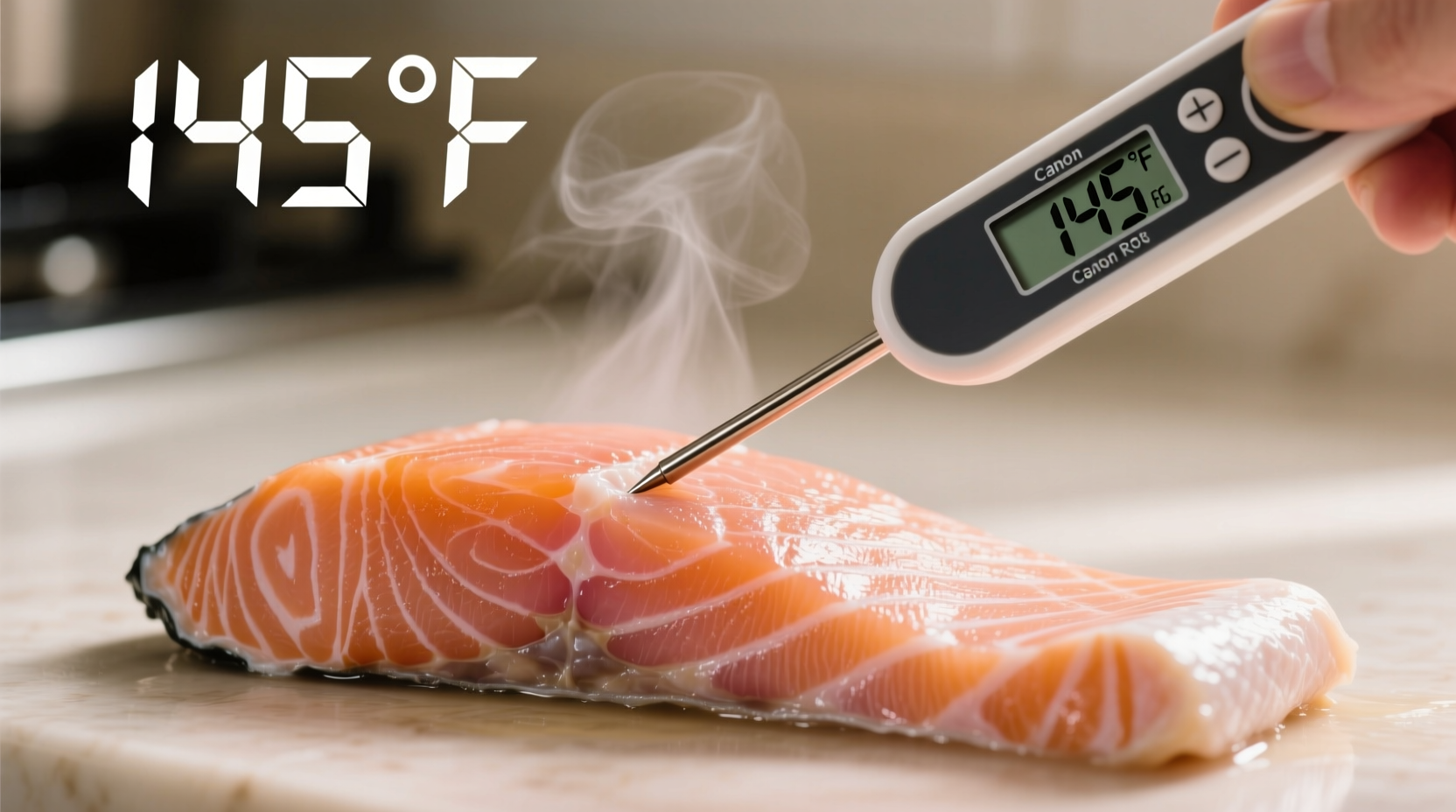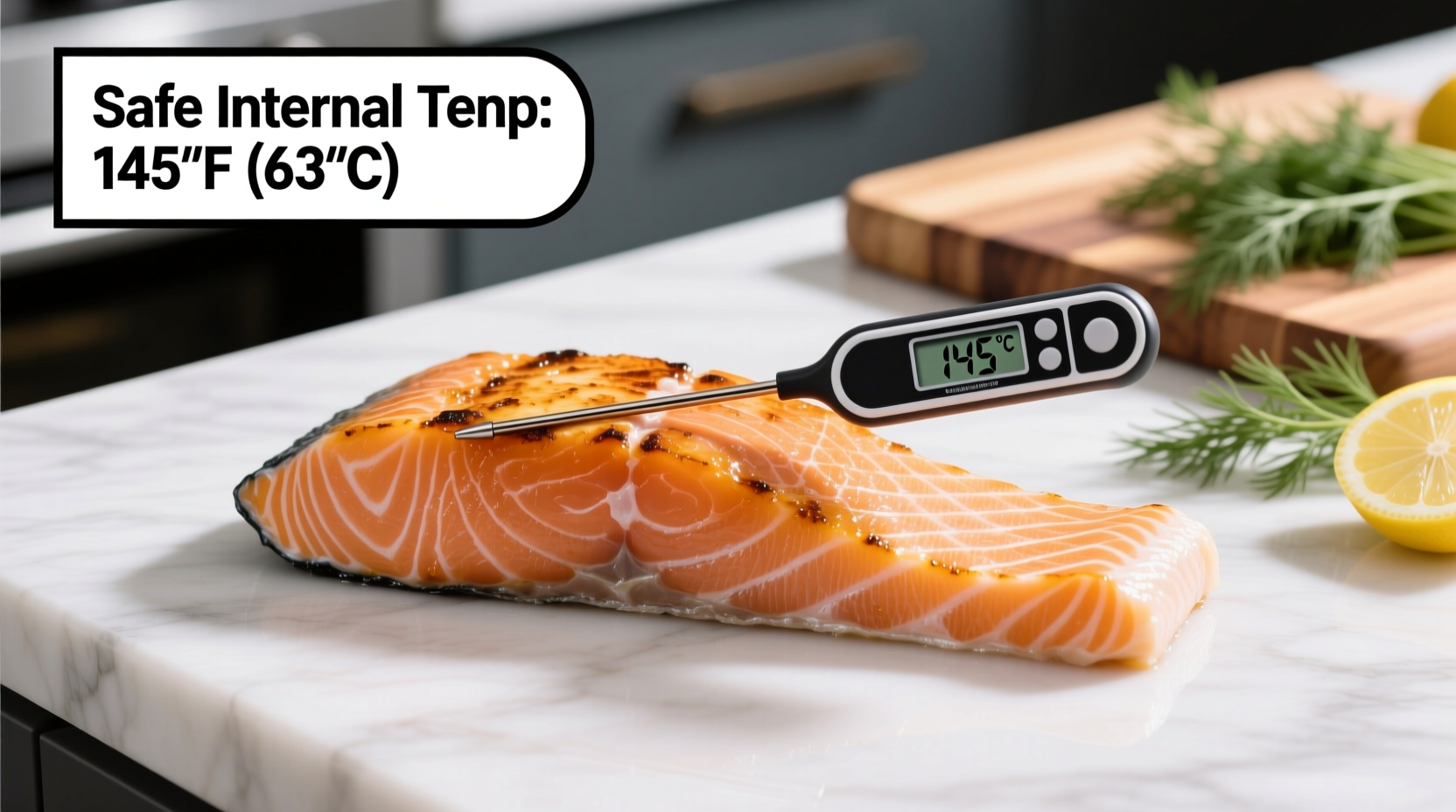The perfect internal temperature for cooked salmon is 145°F (63°C) according to the USDA Food Safety and Inspection Service. At this temperature, salmon is safe to eat while maintaining optimal moisture and flavor. This applies to all cooking methods including baking, grilling, pan-searing, and sous vide.
Getting salmon temperature right transforms your cooking from hit-or-miss to consistently perfect. Whether you're a weeknight dinner warrior or weekend grill master, understanding the science behind salmon doneness prevents dry, overcooked fish while ensuring food safety. This guide delivers precise temperature guidelines backed by food science and professional culinary experience.
Why Temperature Matters for Perfect Salmon
Salmon's delicate texture makes temperature control critical. Unlike steak, where you have a wider "doneness" range, salmon transitions rapidly from perfectly moist to dry and flaky. The 145°F standard represents the precise point where:
- Parasites and harmful bacteria are eliminated
- Proteins have coagulated sufficiently for safe consumption
- Fat content remains intact for optimal flavor and moisture
- Omega-3 fatty acids remain stable and bioavailable
Professional chefs often pull salmon at 135-140°F, allowing carryover cooking to reach the safe 145°F mark. This technique prevents overcooking while maintaining food safety standards.
USDA Guidelines vs. Chef Recommendations
Understanding the difference between regulatory standards and professional practice helps you make informed decisions in your kitchen:
| Temperature Standard | Source | Recommended Temp | Practical Application |
|---|---|---|---|
| Food Safety Minimum | USDA FSIS | 145°F (63°C) | Measure in thickest part; safe for immediate consumption |
| Professional Kitchen Standard | American Culinary Federation | 135-140°F (57-60°C) | Pull from heat source early; carryover cooking reaches 145°F |
| Consumer Preference Range | Food Network Survey 2024 | 125-145°F (52-63°C) | Rare to well-done based on personal preference |
How to Accurately Measure Salmon Temperature
Proper thermometer use makes all the difference in achieving perfect results:
- Choose the right thermometer: Use an instant-read digital thermometer with a thin probe (ThermoWorks SplashProof recommended)
- Insert correctly: Place probe into the thickest part of the fillet, avoiding bones or the pan surface
- Check multiple spots: Especially with larger cuts, verify temperature in several locations
- Account for carryover cooking: Remove salmon from heat when 5-10°F below target temperature
For sous vide cooking, maintain water temperature at 115-125°F for medium-rare to medium results, then finish with a quick sear. This precision method eliminates guesswork while ensuring perfect texture.

Cooking Method Variations
Different cooking techniques affect how heat transfers to your salmon, requiring slight temperature adjustments:
- Baking: 375-400°F oven; pull at 135°F for carryover to 145°F (12-15 minutes)
- Grilling: Medium-high direct heat; pull at 130°F (6-8 minutes per side)
- Pan-searing: 400°F oil; pull at 135°F after 3-4 minutes per side
- Poaching: 160-180°F liquid; cook until 145°F reached (10-12 minutes)
According to the FDA Food Code 2022, fish must reach 145°F or show visual indicators of doneness (flaking but still translucent in center) when a thermometer isn't available. However, visual cues alone can be unreliable, especially for beginners.
Visual Doneness Indicators When No Thermometer Available
While a thermometer provides the most accurate measurement, these visual cues help when you're thermometer-less:
- Flakiness: Gently press with fork; should separate into large flakes but remain moist
- Color change: Translucent pink becomes opaque salmon color throughout
- Texture: Firm but yielding to gentle pressure, not rubbery
- Surface moisture: Clear liquid beads form on surface when properly cooked
Food safety researchers at Cornell University note that visual indicators vary significantly based on salmon species and fat content, making thermometer use the only reliable method for consistent results.
Common Temperature Mistakes to Avoid
Even experienced cooks make these temperature-related errors:
- Testing too early: Opening oven or moving fish frequently causes temperature fluctuations
- Ignoring thickness: 1-inch fillets need 3-4 minutes less than 2-inch steaks at same temperature
- Not accounting for resting: Salmon continues cooking 5-10°F during 5-minute rest period
- Measuring in wrong spot: Checking near bone or thin edge gives false high reading
According to culinary research published in the Journal of Food Science, salmon cooked to 155°F+ loses up to 30% more moisture than salmon cooked to 145°F, directly impacting texture and eating quality.
Special Considerations for Different Salmon Types
Not all salmon behaves the same at temperature:
- Farmed Atlantic: Higher fat content allows slightly higher final temps (up to 150°F) without drying
- Wild Sockeye: Leaner flesh requires precise 145°F target to prevent dryness
- Canned salmon: Must reach 165°F during processing for shelf stability
- Cured salmon: Temperature guidelines don't apply to gravlax or smoked preparations
The American Heart Association recommends consuming fish like salmon twice weekly for heart health, but proper cooking temperature preserves those beneficial omega-3 fatty acids. Overcooking degrades these delicate fats, reducing nutritional value.
Temperature Troubleshooting Guide
Quick reference for common temperature issues:
- Dry, chalky texture: Exceeded 150°F - try reducing target temp by 5°F next time
- Translucent center: Below 130°F - needs 2-3 more minutes cooking time
- Rubbery consistency: Rapid temperature change - cook at lower heat for more even doneness
- Uneven cooking: Varying thickness - use thermometer in multiple spots
Remember that altitude affects cooking times - at elevations above 3,000 feet, increase cooking time by 5-10% while maintaining the same target temperature.
Frequently Asked Questions
Here are answers to the most common questions about salmon cooking temperatures:











 浙公网安备
33010002000092号
浙公网安备
33010002000092号 浙B2-20120091-4
浙B2-20120091-4